First, artificial intelligence is the top technology in the information age;
Second, the ever-wider data pool and the emergence and development of increasingly powerful computer computing functions, coupled with the development of machine learning and deep learning (and more data and computing functions), will affect all companies across the industry. ;
Third, the development of AI-as-a-service will open up a whole new market;
Fourth, Goldman Sachs believes that a company can use AI well. It will gain a favorable competitive advantage;
Artificial intelligence will bring changeFrom human beings telling computers how to do it, to the computer to learn to do it themselves, artificial intelligence is constantly developing. It has a profound impact on the entire industry. Maybe before the arrival of the next winter (AI Winter), we don't know if this is hope or disappointment. But at the very least, these investments and new technologies allow us to enjoy the efficiency and economic benefits of machine learning.
In the past few years, artificial intelligence, robots, and driverless cars have become hot words. We believe that this is a turning point, not the beginning of a failed attempt. There are more obvious reasons (such as more data, faster computer computing power), and some reasons that are less noticeable and more subtle (such as the leap-forward development of deep learning, dedicated hardware, and the increase of open source services) .
The use of artificial intelligence is not limited to the technology world far beyond the horizon, its commercial use abounds, from Apple's Siri (natural language processing), Amazon's Alexa (natural language processing), to Google's mapping technology (Computer vision and image recognition). With the development of technology, the quality of these products and services is also getting higher and higher. When big data is combined with powerful technology, new value-added points and competitiveness are born. Many examples support this argument. In the medical industry, image recognition technology can improve the accuracy of cancer diagnosis. In agriculture, farmers can use deep learning techniques to increase rice production. In the energy industry, exploration efficiency has increased. In the financial services industry, the cost of analysis has decreased and is faster. Although AI is still in its early stages of development, with the gradual popularization of cloud services, we believe that a new wave of innovation is coming, and in the future, in every industry, who is the winner and who is the loser.
We also believe that the widespread use of artificial intelligence will increase efficiency and promote the global economy; for the United States, economic stagflation will stop. As in the 1990s, the bursting of AI technology will encourage large companies to invest more capital in capital and labor-intensive projects to promote economic growth; corporate profit margins and stocks will increase.
Artificial intelligence is a science and engineering that allows machines or computer software to learn and solve some of the knowledge and problems that usually require human intelligence to learn or solve. Artificial intelligence is also describing the computer's attempt to simulate an intelligent behavior; for example, trying to simulate human-like "knowledge," "common sense," "learning skills," and "decision analysis." Traditionally, this includes natural language processing and translation, visual perception, pattern recognition, and decision-making skills, but as the field of artificial intelligence grows wider, the connotation of artificial intelligence becomes more complex.
In this report, our focus is on machine learning and deep learning in artificial intelligence (part of machine learning):
1. In simple terms, machine learning is an algorithm that learns from cases and experiences (such as data sets) rather than through well-programmed or defined rules. In other words, if it is "non-machine learning," programmers need to "tell" a program how to identify apples and oranges, while machine learning is "fed" (training) data and self-learn how to identify apples and oranges. In real life, Netflix guides machine learning through a large amount of user data, recommending customized recommended episodes and products for users; neural network is a simulation of human brain neural network learning. A machine learning architecture of the way, as shown in the following figure:
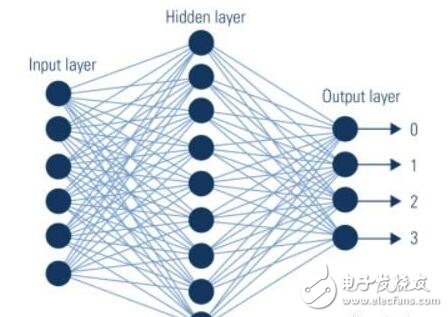
2. Today's artificial intelligence inflection point (AI inflecTIon) is deep learning (this is a different level of focusing on a big problem by interleaving the depth layers of complex neural networks, after collaborating to solve a small problem, Big problem solved). In many traditional machine learning training methods, features (ie, "inputs" or "characteristics" that are predicted) are human-designed. And "feature engineering" is actually a bottleneck that is difficult to break because it requires strong expertise. In unsupervised deep learning (the distinction between supervised and unsupervised learning can be expressed in the following example, the former may be "fed" a series of "keywords", and when these words are detected, they will be labeled as "junk" "mail", while the latter may not be given the relevant information, but the machine itself to explore and identify the pattern [pattern]), the important features are not pre-designed by humans, but self-generated and learned by the algorithm .
Finally, we want to emphasize that we are concerned with the relevant artificial intelligence technology that can be quantified and can quickly generate economic benefits, rather than the strong artificial intelligence that can be thought like humans (even if AlphaGo beats Go Championship is considered in this field). Major breakthrough).
Clear other concepts1. What is supervised learning and unsupervised learning?
a. In supervised learning, the machine improves predictive accuracy by continuously learning the “correct answerâ€, such as spam detection (the system marks them as “spam†whenever certain characters appear);
b. Unsupervised learning is more often given a series of unlabeled examples (and no correct answer), and requires the system to discover a law of its own. Example: Classify consumers with certain characteristics (for example: frequency of purchases).
2. What are some of the categories of machine learning?
a. Classification (ClassificaTIon): spam classification, fraud identification, face recognition, speech recognition, etc.
b. Clustering: Comparing pictures, texts, or finding similar things to determine the "category" of anomalies.
c. Predictive (PredicTIve): predicts health problems based on data from wearable devices, and estimates the turnover rate of customers and employees based on network activity.
3. What is Strong/Intelligent Intelligence (General/Strong/True ArTIficial Intelligence)
Strong artificial intelligence refers to machine intelligence that can think and make decisions independently like humans. Although there is already a Whole Brain Emulation, the amount of computation required for this technology is too large to exceed the level of the prior art; it is still in the theoretical stage.
A brief history of artificial intelligence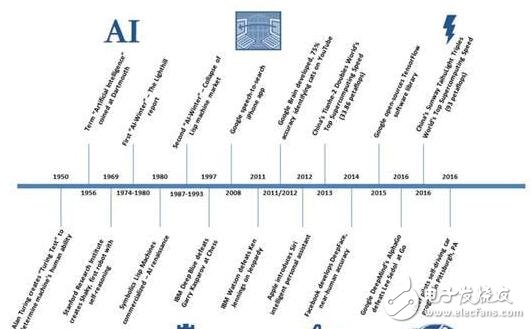
Goldman Sachs believes that there are four major factors: data, talent, infrastructure, and silicon.
1. Goldman Sachs believes that data is the most critical element. The increase in data can effectively improve accuracy (refer to the Harvard Medical School and Massachusetts General Hospital radiology report on the accuracy of CT image diagnosis). The current deep learning is subject to human participation in regulation. Even the so-called “semi-supervised learning†still requires humans to supply a large amount of data (at least some of which are labeled). It does not require human self-learning at all, and it is the "Holy Grail" pursued by deep learning now, which has not yet been realized. However, there is already a lot of data now, and they will increase even more. The annual compound growth rate of data worldwide will be 36% in 2020, and the total amount will reach the order of 44 billion GB. We believe that electronic health records, weather, and geographic data will be the driving force behind the next 20 years.
2. Talent shortage is a key factor that constrains artificial intelligence, especially deep learning. This has also led to frequent acquisitions among companies over the past few years (Exhibit 5). We have found that as technology develops, the constraining effect of this factor on the development of artificial intelligence will become slightly weaker because of the large amount of data. It will be a key element in advancing the development of the artificial intelligence industry.
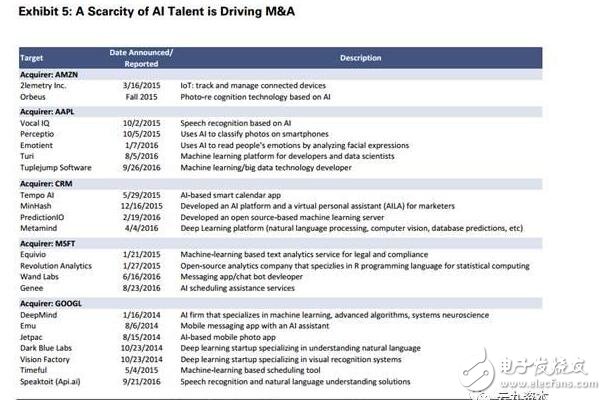
3. The development of artificial intelligence relies heavily on hardware and infrastructure. With the improvement of the latter two, artificial intelligence will develop rapidly. Here we provide two insights. First, cloud computing providers are ready to provide services for artificial intelligence; second, open source platforms such as TensorFlow, Caffe, and Spark have mushroomed and have become the backbone of innovation in artificial intelligence software.
4. Silicon: The algorithm of machine learning is a resource-intensive thing, usually done by a GPU (graphics processor) system. At present, for the unique operation mode Inference in machine learning, many companies have provided corresponding solutions (Special Silicon FPGA and ASIC; Field Programmable Gate Array and ASICs Application Specific Integrated Circuit), such as Google's Tensor processor unit, which is ASIC. A special artificial intelligence chip, while Microsoft is an FPGA chip. Xilinx, a leading company that has focused on FPGA chip commercials since the end of 1980, says that future cloud computing and offline data centers are new revenue growth points in the future.
Why is the development of artificial intelligence suddenly accelerating?The leap-forward development of deep learning has led to the rapid development of artificial intelligence to near the turning point. Neural networks, the underlying framework for deep learning, have been around for many years. In the past decade, what really promotes deep learning is that Goldman Sachs believes that it is the following factors: more data (such as a large number of new devices connected to the Internet of Things generated data; 2020 data is expected to be four times in 2015; 1), faster hardware (GPU, CPU performance is greatly improved: since 1993, the original computing power of supercomputer has been greatly developed; a high-end NVIDIA graphics card in 2016 can be operated by a supercomputer before 2002. (Figure 2), and the relevant price is lower year after year [price per unit "computation"] (Figure 3)) and there are more quality algorithms to choose from (a large number of high quality open source algorithms can help promote artificial intelligence) Developments such as Berkeley's Caffe, Google's TensorFlow).
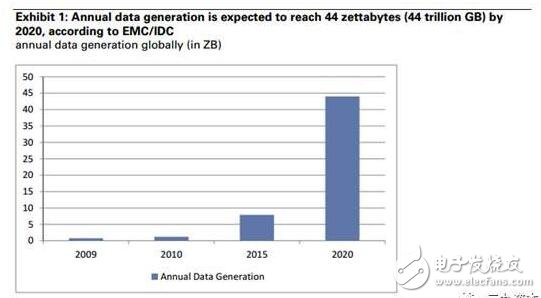

The main impact of artificial intelligence is concentrated in four aspects: productivity, advanced technology, competitive advantage, and the birth of a new company.
1. Productivity: AI and machine learning will encourage companies to save some labor-related expenses and really spend their budget on developing products and improving services (Jan Hatzius, chief economist at Goldman Sachs); macroscopically, social efficiency is improved, economy Will develop.
2. High-end technology: AI and machine learning make building data centers less expensive, which will overturn the market share of related hardware and software and hardware and software services companies. For example, the same GPU computing request, using AI optimized GPU requires $ 0.9 / hour, now through the Amazon cloud service, only $ 0.0065 / hour can be achieved.
3. Competitive advantage: If AI and machine learning cannot be used in time to guide business development, competitors will seize the opportunity: strategic intelligence, productivity improvement, and effective capital utilization (in the upcoming "Next", We will discuss in particular the changes that artificial intelligence brings in the medical, energy, retail, financial and agricultural industries.
4. The birth of the new company: venture capital, entrepreneurs, and technologists will jointly promote the development of AI technology and create new value. The next "AI Google, Facebook" may be coming.
Impact on consumersConsumers can enjoy smarter search optimization (such as Google's new RankBain artificial intelligence search system) and find that search engines have become smarter (such as Amazon DSSTNE engine and Netflix use artificial intelligence systems to help decide which ones to recommend) Movies, products, songs to users), their faces become more recognizable (face recognition - such as Google's FaceNet and Facebook's DeepFace can achieve nearly 100% face recognition accuracy).
Artificial Intelligence and ProductivityUS productivity growth has entered a sluggish state in recent years, and we believe that the development of artificial intelligence can change this situation, not only in the United States, but also globally, just like the changes made by Internet technology in the 1990s.
We found that in different industries, we have observed that automation has reduced the average worker time by 0.5%-1.0%, while the efficiency of artificial intelligence and machine learning can bring +51-154bps (base point) by 2025. The efficiency is improved. However, this mainly affects the low-paying tasks; the early impact will be the automation of low-wage tasks, which will drive similar levels of output growth with less labor time.
Technology and productivityThe technological explosion of the 1990s prompted economic growth, and two productivity factors were greatly improved: one was the capital deepening indicator, and the other was multifactor productivity.
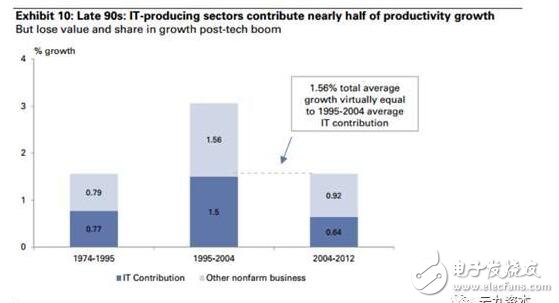
But after 2000, capital deepening has stagnated. The use of IT (computer hardware, software, telecommunications) in the contribution of capital is gradually decreasing, while working hours have increased. With the introduction of more complex, more "consumer-version" machine learning and artificial intelligence, capital depth may increase and may increase productivity dramatically. However, when we talk about productivity, the impact of some “untouchable†outputs (such as online content) on productivity may be neglected.
The Paradox of Artificial Intelligence and Productivity: An Interview with Goldman Sachs Chief Economist Jan Hatzius:
In the interview, Mr. Jan Hatzius made several points (excerpts related to the topic of artificial intelligence are as follows):
1. Economic cyclicality, slowing of technological change, statisticians' statistical tools cannot accurately quantify the progress of the latest technology, leading to a slowdown in technology-driven economic growth after 2000 (at least as far as the data itself is concerned).
2. The introduction of artificial intelligence is obvious for the improvement of productivity (see Figure 13: The technological revolution of the 1990s promoted the increase of productivity. The number of software companies surged from 1995 to 2000, and the number was reduced until 2000.) But in terms of per capita economies of scale, it may not be so obvious.

3. Concerns about artificial intelligence taking away human work have also occurred in the industrial revolution of the 19th century. In the short term, there will indeed be more people unemployed. But in the long run, artificial intelligence does not lead to an increase in unemployment.
Artificial intelligence "ecosystem": cloud services, open sourceWe believe that artificial intelligence will affect all industries, which is a new competitive advantage; at the same time, management who ignores this trend may not be able to have an advantage in product innovation, labor efficiency and capital leverage. Therefore, we believe that the company's demand for artificial intelligence will drive the talent, service and hardware requirements for artificial intelligence.
As shown in Figure 14, over the past 20 years, more and more venture capital has entered the field of artificial intelligence and machine learning.


The concept of artificial intelligence has long been proposed. Among them, the concept of neural network has been proposed in the 1960s, but until recently, because of the improvement of computing power, we can really use these technologies in practice; at the system architecture level, we can see So, from the beginning of the mainframe, to the subsequent client, to the recent cloud/mobile, including the emergence of new programming languages ​​(see Figure 15), these are the computing power, storage capacity, bandwidth improvement effect; We believe that we are still in the early stages of the development of artificial intelligence, and that various tools and services will explode.
Artificial intelligence promoter
1. Do-It-Yourself Enterprises: Companies with outstanding talents and large amounts of data should build their own machine learning teams. At this point, we can see that the AI ​​heap is forming, and we believe that it includes open source (such as vendors like Databricks, Cloudera, Hortonworks) and services provided by cloud platforms (such as Microsoft, Google, Amazon, and Baidu).
2. Consulting company: AI is still a scarce resource, so companies like IBM are building a horizontal and vertical industrial business technology advantage through IBM Watsons. And companies like Kaggle help companies solve the problem of artificial intelligence through thousands of data scientists.
3. AI as a service (AI-as-a-service, AI-aaS): This is a noun we define ourselves, which means that companies do not need to train AI themselves, but they can be trained through direct use by third-party companies. Good depth learning AI machines. An example: startup Clarifai and Google Inc. focus on the AI-aaS of the Image API. Another example: sales data unique to Salesforce.com. Companies with unique data will have a competitive edge.
Machine learning (especially deep learning) is a relatively new field of artificial intelligence. And we believe that this novel technology is being used by Internet companies, companies that specialize in providing industry-specific services, Fortune 500 companies, and many others. The obstacles to the development of artificial intelligence: data and talent have been gradually removed; companies have gradually learned to collect data through the Internet of Things, which makes up for the lack of data before. A large number of graduates of the emerging machine learning profession and more and more consulting firms related to artificial intelligence have filled the gaps in talents. We believe that most large companies (or small and medium-sized companies that focus on data) will at least try machine/deep learning. Because of the slow pace of innovation, it will be difficult to create a complete pipeline of machine learning products. Many times, these developments are more “fragmentedâ€.
Blue is a proprietary supplier, orange refers to open source, green refers to cloud services (some suppliers, such as Alibaba and Baidu, are proprietary, cloud services coexist).
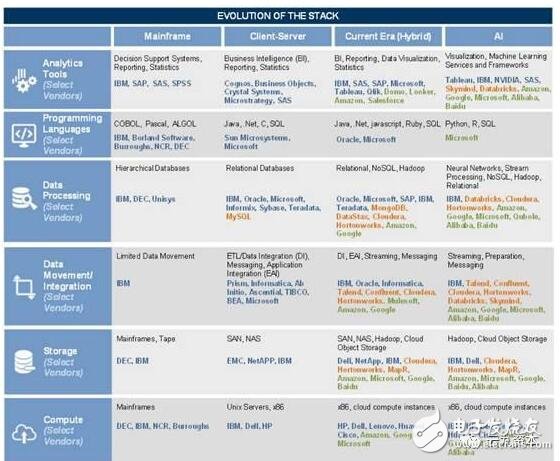
The gradual rise of the AI ​​"heap" has similar tools, languages, and storage as the previous host and client.
But the difference between the AI ​​heap and the previous technology is that the machine learning product pipeline is very dependent on the open source technologies and services provided by the third-party cloud platform.
There are three main reasons for this change. 1) Machine learning requires continuous online computing and storage to calculate and store large amounts of data. 2) Microsoft, Amazon, and Google are investing heavily in machine learning. The three major customers embrace open source to prevent " Vendor lock-in and cut expenses
China's artificial intelligence situationAccording to the analysis report of iResearch, the artificial intelligence market in China will increase from RMB 1.2 billion in 2015 to RMB 91. But as far as 2015 is concerned, there are 1.4 billion yuan (up 76% from 2014) of capital inflows into the market.
In May 2016, the National Development and Reform Commission and other relevant departments issued the “Internet + Artificial Intelligence Three-Year Action Implementation Planâ€. The program pointed out six areas of protection: capital support, system standardization, intellectual property protection, personnel training, international cooperation and landing measures; and focused on completing the construction of AI infrastructure and corresponding innovation platform, matching industrial system and innovative services in 2018. System and basic standardization system.
China has made breakthroughs in artificial intelligence. On the data of the number of cited papers with the “deep learning†or “deep neural network†keywords, China has surpassed the US in this value in 2014 (Figure 24). China's artificial intelligence research capabilities are also amazing (Figure 23), especially in terms of speech and visual recognition technologies. Baidu’s Deep Speech 2 system, released in November 2015, has achieved 97% accuracy and is even one of the top ten breakthrough technologies of the MIT Technology Review 2016. The DeepID system developed by the Chinese University of Hong Kong achieved a face recognition accuracy of 99.15% in LFW (Labelled Faces in the Wild).
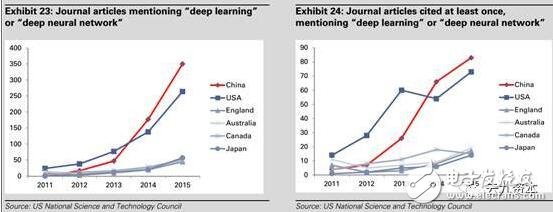
Hundreds of Chinese artificial intelligence companies are infiltrating into this industry, but the industry leaders are still Baidu, Alibaba and Tencent (BAT) (see the chart below for each company's products; you can see that Baidu focuses on speech recognition ( Deep Speech), natural language processing, to optimize the personal voice assistant "degree secret", search, map use; Baidu also has its own unmanned car department; Alibaba has developed artificial intelligence customer service, cloud-based artificial intelligence platform DT PAI, Alibaba's optical character recognition, and Alibaba Cloud ET artificial intelligence suite; Tencent (Yu Tu) is devoted to face recognition technology, search, natural language processing, data mining, artificial intelligence, news reporting, and Hong Kong University of Science and Technology. Established a joint laboratory for artificial intelligence).
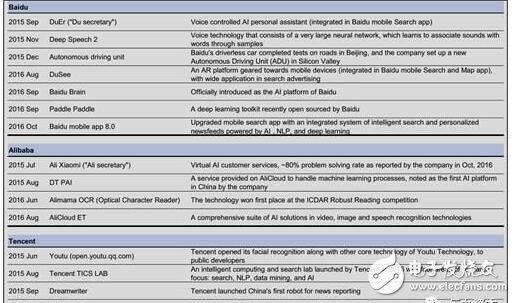
At present, China's artificial intelligence mainly focuses on the following areas:
1. Basic services (such as data resources and computing platforms)
2. Hardware products (such as industrial robots and service robots)
3. Intelligent services (such as intelligent human services and business intelligence)
4. Technical ability (visual recognition, machine learning)
Voice and visual recognition technologies account for 60% and 12.5% ​​of the artificial intelligence market in China.
Of the companies associated with artificial intelligence, 71% are dedicated to application development and 29% focus on algorithms.
Of the companies that focus on algorithms, 55% are working on computer vision, 13% are focusing on natural language processing, and 9% are focusing on basic machine learning.
In our eyes, the leader of artificial intelligence will continue to be produced in China and the United States.
We list motion control and robotics, speech recognition and replication, geospatial perception, image perception and recognition, artificial neural networks and infrastructure, audio sensing and processing, system monitoring and resource allocation, training and Inference silicon, and natural language processing. , the leader in environmental sensors (humidity, temperature, etc.).
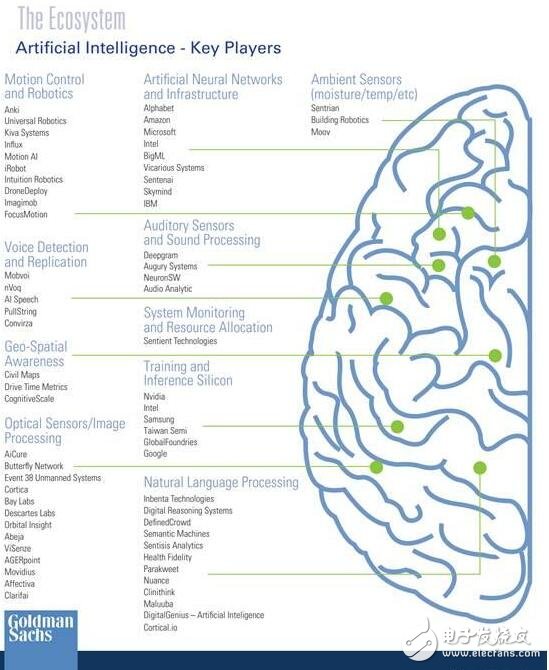
Sky9Capital Cloud Nine Capital () is an early venture capital fund brand focused on the Chinese market, focusing on innovative Internet, enterprise services and cutting-edge technology industries.
L Series Lead Acid Battery,Custom Valve Regulated Battery,12V 38Ah Battery,12V 65Ah Lead Acid Battery
Wolong Electric Group Zhejiang Dengta Power Source Co.,Ltd , https://www.wldtbattery.com